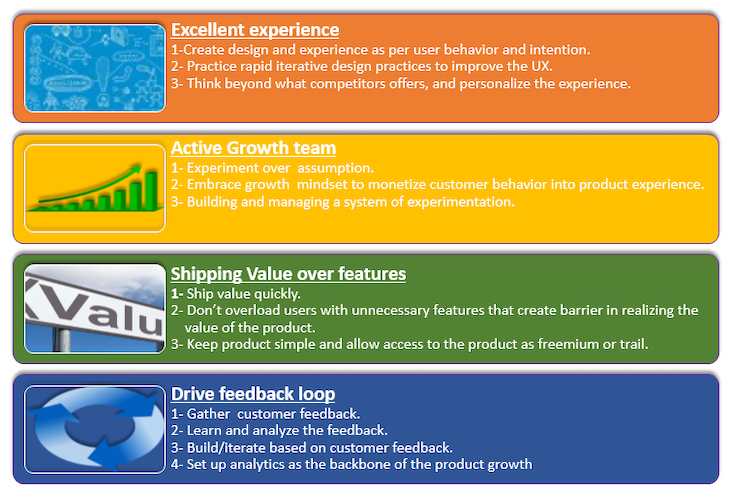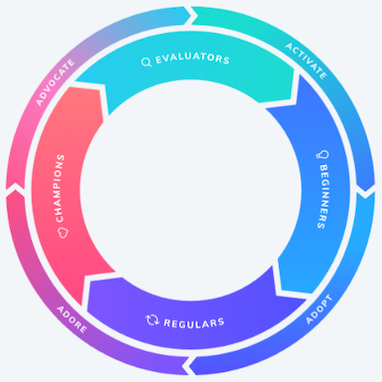Product-led growth puts the product at the center of everything the organization does. The objective of any product-led growth strategy is to build a product that enables growth through an excellent user experience.

In product-led growth, the entire organization works to engage and serve customers in the growth loop, commonly known as the product-led growth flywheel. The growth flywheel becomes a revenue and expansion source without much human intervention.
Lately, product-led growth has gained massive popularity, seeing many startups and big companies scaled up faster while keeping sales and marketing costs low.
Zoom, Slack, Pinterest, Grammarly, and Calendly are a few examples of product-led growth companies that exhibited compounding successes by delivering a world-class, personalized user experience, continuous innovation, and undeniable value.
The paradigm of user behavior is shifting. Customers demand an outstanding experience if they are to stick with a product, and product-led growth places the user and their needs front and center.
In product-led growth, the user experience (UX) and product experience (PX) are the main drivers for customer acquisition, activation, satisfaction, and retention. Product managers consider product metrics to be the backbone of growth and the key to scaling a product.
PMs who focus on product growth metrics are called growth product managers (GPMs). The growth PM’s objective is to ship value through the product to achieve business outcomes. This value is optimized when teams embrace principles of agility to respond quickly to change to minimize the time to market.
To validate these changes, growth PMs create experiments, including running A/B tests and gathering customer feedback through surveys and interviews to validate whether changes to the PX are likely to drive loyalty and retention.
Growth PMs usually work in a fast-paced environment and are metrics-driven and goals-oriented. This focus on metrics and KPIs helps them keep an eye on the customer journey throughout the conversion funnel. Any drop in the baseline prompts the growth PM to look for opportunities to tweak the product-led growth strategy.
Unlike traditional PMs, growth product managers rely on short experiments to track success around customer acquisition, conversion and retention, and scalability. Regular product managers are more focused on discovering customer pain points and working closely with design and engineering to ship value in the form of features and capabilities to solve customer pain points.
Growth PMs, on the other hand, work with engineering, analytics, UX, design, business stakeholders, and marketing to improve the aforementioned metrics and exhibit adaptability and flexibility through cross-collaboration.
Typically, growth PMs do not favor a procedural approach or playbook-aligned process. Growth engines are not one-size-fits-all; likewise, growth PMs are dynamic and believe in identifying core issues and continuously adjusting the growth strategy accordingly.
These are the four principles of product-led growth:
An excellent user and product experience enables retention and acquisitions. Nothing is worse for a product-led organization than losing potential customers.
An outstanding design and product experience ensure a frictionless and intuitive customer journey, which enables users to develop behavior and patterns that they’re comfortable with, an expected outcome of practicing product-led growth.
A comfortable behavior pattern translates into an outstanding user and product experience that adds value to customers’ day to day lives and helps them get their jobs done.
An active growth team is an important pillar of the product-led organization. It enables the delivery of products to market, customer acquisition, conversion, and expansion.
To do this, the growth team captures value through products to remain profitable in the short and long term. It does this by actively running experiments and refusing to settle for a one-size-fits-all process or a growth strategy that does not create value for customers.
Failing and pivoting fast are two important approaches for the active growth team in a product-led organization.
Shipping value over features is critical for product-led growth. The product enables growth, so customers must understand how products improve their day-to-day life.
During the initial exploration phase, there is a short window of time during which a user must recognize the value of your product. If they do, this realization is likely to convert a lead into an existing customer.
On the contrary, delivering shiny new features may be eye-catching, but it doesn’t actually help customers realize that value and thus doesn’t support product-led growth.
For example, a potential lead who experiences the free trial version of Zoom (40-minute call limits — sound familiar?) typically buys the paid version to get an uninterrupted experience. Product value lies not only in the paid version but also in a freemium model that acts as an entry point for customer conversion and the growth flywheel.
Customers appreciate a curated experience when they use a product. The best way to achieve this is to understand the customers’ needs and pain points by actively listening to them on an ongoing basis.
The idea behind product-led growth is to scale the product according to customer feedback rather than building it based on assumptions. Surveys, experiments, and discovery sessions are widely adopted practices in any product-led organization to analyze the customer journey through insights and trends.
In return, a closed feedback loop increases customer retention and enables acquisitions through an enhanced experience.
The principles of product-led growth can be summarized as follows:

Best-of-breed product-led companies include:
These companies use a product-led growth strategy that allows customers to discover the value of their products through freemium or trial versions. This strategy often triggers activation and acquisition because it enables users to experience the value that initiates the purchase.
Instead of spending money on marketing and sales tactics (e.g., sales-led growth), adopting a product-led growth approach helps organizations focus on scaling and improving the product through best-in-class UX and PX.
These companies make data-driven decisions and focus on user intention and behavior as the key to improving the product. They quantify the customer intention to improve the customer journey through personalization and one-of-a-kind features to provide aha moments.
Further, product-led companies develop a growth mindset across the organization, from executives to internal and external stakeholders.
What keeps them aligned is the north star metric, a common goal that the organization is striving to achieve. The north star is the way to tap the sweet spot of the customer value and the business. It also ensures that, instead of becoming a shipping feature factory, the company focuses on delivering value that makes a difference in customers’ lives.
Every product-led growth organization has its north star metrics. For example, Zoom’s north star metric is average weekly hosted meetings.
The product-led-growth flywheel is a strategic framework that breaks the customer’s journey into four key phases :
The users’ actions at each phase exhibit their behavior around activate, adopt, adore, and advocate metrics. This is what’s called the flywheel growth effect, which turns freemium customers into paid customers.

This flywheel is closely related to the concept of AARRR, or pirate metrics, introduced by Dave McClure, a Silicon Valley investor and founder of 500 Startups.
Now let’s look for some SaaS metrics that help PMs generate the insights they need to measure the growth driven by the product-led flywheel:
Time to value is the time it takes a new user to realize the product’s value. Short time to value leads to higher rates of activation.
The goal is to keep time to value as low as possible. This metric lies between the two phases of the product-led flywheel: evaluator and beginners.
One of the key elements of product-led growth is to convert users with a free trial to a paid account. The PQL insights capture those users who are close to the adoption stage and ready for conversion.
Expansion revenue is an important growth metric that measures the revenue generated through upsells, add-ons, cross-sells, personalization, etc.
The higher the value of expansion revenue, the better.
ARPU is the average amount of money an individual user spends every time they visit the product.
ARPU is a good indicator of the growth of a subscription-based model business. The higher the value of ARPU, the healthier the business.
Net churn measures the percentage of money lost after accounting for new, expansion, and re-activated revenue.
Net churn percentage is calculated as follows:
Net revenue churn % = (Revenue lost during period – new, expansion, and reactivation revenue) / Revenue at the beginning of the period
This figure helps account for how customer churn impacts the business.
For example, let’s say you lost customers of $50 in revenue and simultaneously received $100 through expansion, reactivation, and new customers. The net churn would be negative ($50-100)= -$50. Net negative churn is a good sign.
Virality facilitates an exponential increase in the rate of adoption as more and more people share and recommend your product. It’s like acquiring new users that existing users can bring onboard through word of mouth and sharing positive feedback.
Virality is a powerful metric for subscription-based products. If the virality metric is high, the product stands to grow exponentially.
In a product-led go-to-market strategy, the product plays a key role in attracting, retaining, and acquiring customers. This is unlike traditional sales-led strategies where a huge sales workforce builds a procedural and budgeted plan to roll the product.
The entire product-led GTM strategy is driven by customer behavior, product usage, and customer experience, which activate the conversion funnel across the product-led growth stages.
Product-led GTM is quite iterative and agile because product-led companies pivot their GTM strategy quite often. Moreover, marketing and branding messages and campaigns are tweaked constantly through data-driven insights about product usage and CX across various channels and devices.
A product-led GTM strategy considers several thought-provoking anecdotes exhibited during the customers’ product journey.
For example, specific user segments retain for longer and show better lifetime value (LTV) compared to other segment types that often churn after the first purchase; prospects use the freemium but refrain from purchasing the subscription. New users’ actions exhibit virality and a network effect, but existing users don’t share or refer the product to others, etc.
These insights allow product-led GTM strategy to evolve as per the need and value.
The primary difference between sales-led and product-led go-to-market is that the latter seeks to acquire customers by allowing them to use the products rather than pushing them through the traditional lead generation channels: cold calling, emails, lengthy form filling for collecting lead information, etc. This approach fixes the issue of bad lead generation and derisks the sales effort and time spent nurturing bad leads.
Product-led GTM also keeps the customer acquisition cost as minimal as possible. Signing up for complimentary trials thus becomes a more meaningful lever.
Product-led companies such as Zoom and Slack are growing fast through product-led GTM strategies that help them personalize the customer journey based on user intention, which leads to conversion.
Before adopting a product-led growth strategy, you must determine whether it’s a suitable approach for your company. Business leaders must evaluate the risks and costs associated with offering free access to products.
Product-led growth is about the customer and the product experience. Customers expect good support, even if they’re only using a freemium version of the product.
Of course, any support team needs a good infrastructure and CRM support, which isn’t free. You might find yourself embracing product-led principles at the expense of missing your bottom line. However, enabling prospective customers to try your product for free could be central to a growth strategy that stands to pay back those losses over time.
Organizations looking to adopt a product-led growth strategy should take the following steps:
The org transformation that takes place to adopt the product leg growth strategy is summarized below-
It’s common for product-led companies to offer free access to their products at the beginning of the conversion cycle. This can come in the form of a sign-up, free trial, freemium version, and more.
As companies transition to a product-led approach, they become more user-focused and depend on the customer lifecycle as the primary way to acquire, adopt, retain, and scale their customer base. They constantly manage and optimize the customer journey and start using real-time customer activities to make their experience better.
Product-led companies use comprehensive customer data to make an informed decision on what to build next. Further, they plan and execute the GTM strategy based on the customer’s real-time data and product usage.
To wrap up this comprehensive guide, below are five key takeaways for organizations looking to embrace a product-led growth mindset:
By embracing the principles and activities described above, you’ll be well on your way to transforming your organization into a product-led growth machine.
Featured image source: IconScout

LogRocket identifies friction points in the user experience so you can make informed decisions about product and design changes that must happen to hit your goals.
With LogRocket, you can understand the scope of the issues affecting your product and prioritize the changes that need to be made. LogRocket simplifies workflows by allowing Engineering, Product, UX, and Design teams to work from the same data as you, eliminating any confusion about what needs to be done.
Get your teams on the same page — try LogRocket today.

A practical five minute revenue estimation method to help product managers compare ideas, drop low impact features, and prioritize smarter.

A practical guide for PMs who want to stop being bottlenecks, delegate smarter, and lead teams effectively with a clear ownership framework.

Stop letting unreliable data block features. Treat data as inventory to track quality, ownership, and ship with confidence.

Learn why slide decks slow teams down and explore better tools like whiteboards, PRDs, and prototypes to improve collaboration and alignment.